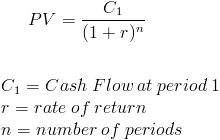Present value, also known as discounted value, is a financial calculation that measures the worth of a future amount of money or stream of payments in today’s dollars adjusted for interest and inflation. In other words, it compares the buying power of one future dollar to purchasing power of one today
It’s an indication of whether the money an investor receives today can earn a return in the future. PV is widely used in finance in the stock valuation, bond pricing, and financial modeling.
Investors calculate the present value of a firm’s expected cash flows to decide if the stock is worth investing in today. The firm’s expected cash flows are discounted at a discount rate that is actually the expected return. The discount rate is inversely correlated to the future cash flows. The higher the discount rate, the lower the present value of the expected cash flows.
Use of Present Value Formula
The Present Value formula has a broad range of uses and may be applied to various areas of finance including corporate finance, banking finance, and investment finance. Apart from the various areas of finance that present value analysis is used, the formula is also used as a component of other financial formulas.
